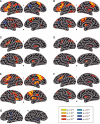FMRI of past tense processing: the effects of phonological complexity and task difficulty
- PMID: 16494687
- PMCID: PMC1679797
- DOI: 10.1162/089892906775783633
FMRI of past tense processing: the effects of phonological complexity and task difficulty
Abstract
The generation of regular and irregular past tense verbs has been an important issue in cognitive science and has been used to advance different models of the organization of language in the brain. The dual-system view holds that the regular past tense forms are generated by a rule while irregular forms are retrieved from memory. The single-system view, on the other hand, holds that both forms are generated by a single integrated system and differ only in their reliance on factors such as phonology and semantics. We conducted an event-related fMRI study to examine the activation patterns associated with the generation and reading of regular and irregular past tense forms, in addition to the reading of their stems. Regular and irregular past tense generation activated similar brain regions compared to the reading of their respective stems. The areas activated more for irregular generation compared to regular generation included inferior frontal, precentral, and parietal regions bilaterally. This activation can be interpreted as reflecting the greater attentional and response selection demands of irregular generation. Compared to irregular generation, regular generation activated a small region in the left superior temporal gyrus when the regular and irregular past tense forms were mismatched on phonological complexity. No areas were more activated for regulars than irregulars when the past tense forms were matched on this variable. This suggests that the activation specific to regulars was related to the higher phonological complexity of their past tense forms rather than to their generation. A contrast of the reading of regular and irregular past tense forms was consistent with this hypothesis. These results support a single-system account of past tense generation.
Figures

Similar articles
-
Imaging the past: neural activation in frontal and temporal regions during regular and irregular past-tense processing.Cogn Affect Behav Neurosci. 2005 Sep;5(3):282-96. doi: 10.3758/cabn.5.3.282. Cogn Affect Behav Neurosci. 2005. PMID: 16396090
-
The past tense debate: is phonological complexity the key to the puzzle?Neuroimage. 2011 Jul 1;57(1):271-280. doi: 10.1016/j.neuroimage.2011.04.008. Epub 2011 Apr 12. Neuroimage. 2011. PMID: 21511040
-
Temporal and frontal systems in speech comprehension: an fMRI study of past tense processing.Neuropsychologia. 2005;43(13):1963-74. doi: 10.1016/j.neuropsychologia.2005.03.008. Epub 2005 Apr 18. Neuropsychologia. 2005. PMID: 16168736 Clinical Trial.
-
Deficits for semantics and the irregular past tense: a causal relationship?J Cogn Neurosci. 2004 Sep;16(7):1159-72. doi: 10.1162/0898929041920559. J Cogn Neurosci. 2004. PMID: 15453971 Clinical Trial.
-
Overregularization in language acquisition.Monogr Soc Res Child Dev. 1992;57(4):1-182. Monogr Soc Res Child Dev. 1992. PMID: 1518508 Review.
Cited by
-
Activation of sensory-motor areas in sentence comprehension.Cereb Cortex. 2010 Feb;20(2):468-78. doi: 10.1093/cercor/bhp115. Epub 2009 Jun 22. Cereb Cortex. 2010. PMID: 19546154 Free PMC article.
-
Lesions impairing regular versus irregular past tense production.Neuroimage Clin. 2013 Oct 14;3:438-49. doi: 10.1016/j.nicl.2013.10.005. eCollection 2013. Neuroimage Clin. 2013. PMID: 24273726 Free PMC article.
-
Longitudinal changes in resting-state fMRI from age 5 to age 6years covary with language development.Neuroimage. 2016 Mar;128:116-124. doi: 10.1016/j.neuroimage.2015.12.008. Epub 2015 Dec 12. Neuroimage. 2016. PMID: 26690809 Free PMC article.
-
Neural Mechanisms of Learning and Consolidation of Morphologically Derived Words in a Novel Language: Evidence From Hebrew Speakers.Neurobiol Lang (Camb). 2024 Sep 11;5(4):864-900. doi: 10.1162/nol_a_00150. eCollection 2024. Neurobiol Lang (Camb). 2024. PMID: 39301207 Free PMC article.
-
Beyond consensus: Embracing heterogeneity in curated neuroimaging meta-analysis.Neuroimage. 2019 Oct 15;200:142-158. doi: 10.1016/j.neuroimage.2019.06.037. Epub 2019 Jun 20. Neuroimage. 2019. PMID: 31229658 Free PMC article.
References
-
- Alexander GE, Crutcher MD, DeLong MR. Basal ganglia-thalamocortical circuits—Parallel substrates for motor, oculomotor, prefrontal and limbic functions. In: Uylings HBM, Van Eden CG, DeBruin JPC, Corner MA, Feenstra MGP, editors. Progress in brain research. Vol. 85. Elsevier; New York: 1990. pp. 119–146. - PubMed
-
- Baayen RH, Piepenbrock R, Gulikers L. The CELEX Lexical Database [CD-ROM] Philadelphia: 1995.
-
- Beretta A, Campbell C, Carr TH, Huang J, Schmitt LM, Christianson K, Cao Y. An ER-fMRI investigation of morphological inflection in German reveals that the brain makes a distinction between regular and irregular forms. Brain and Language. 2003;85:67–92. - PubMed
-
- Binder JR, Frost JA, Hammeke TA, Bellgowan PS, Rao SM, Cox RW. Conceptual processing during the conscious resting state. A functional MRI study. Journal of Cognitive Neuroscience. 1999;11:80–95. - PubMed
-
- Binder JR, Frost JA, Hammeke TA, Bellgowan PS, Springer JA, Kaufman JN, Possing ET. Human temporal lobe activation by speech and nonspeech sounds. Cerebral Cortex. 2000;10:512–528. - PubMed
Publication types
MeSH terms
Substances
Grants and funding
LinkOut - more resources
Full Text Sources
Medical
Miscellaneous

